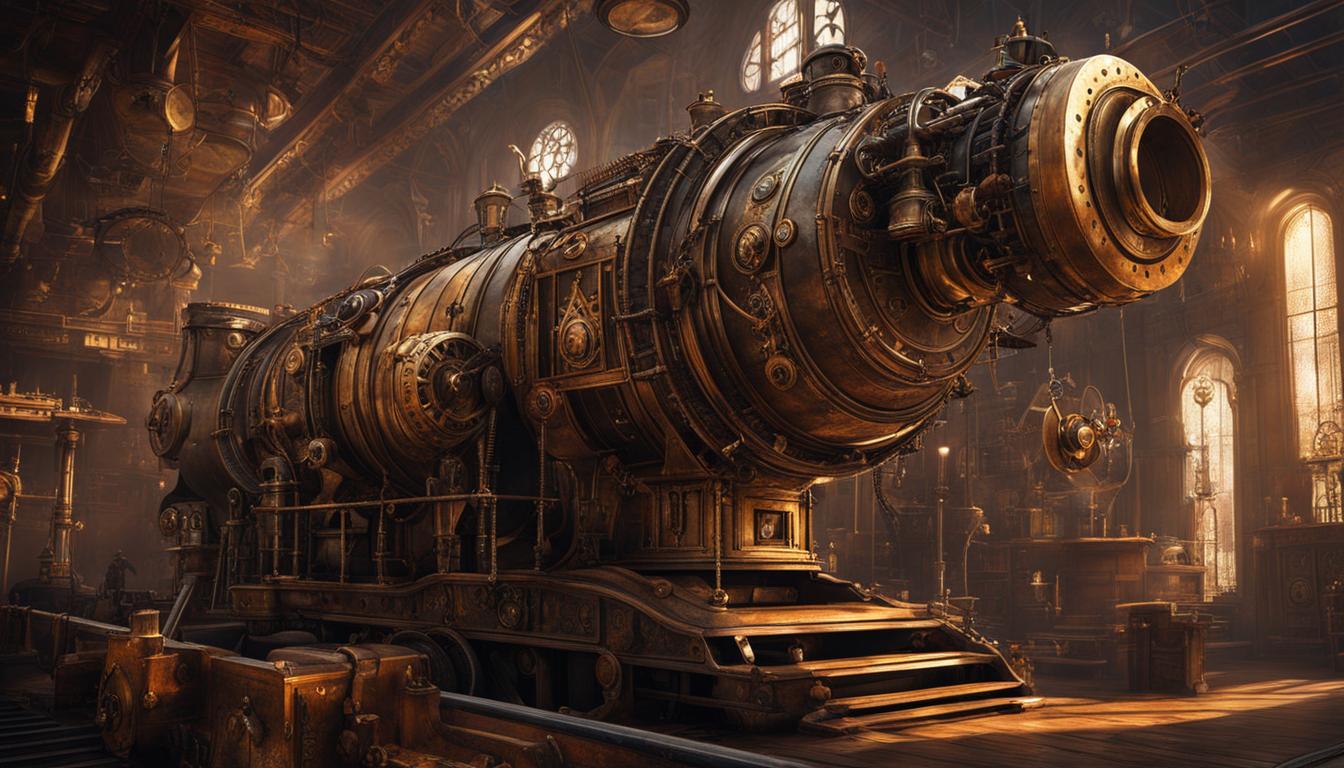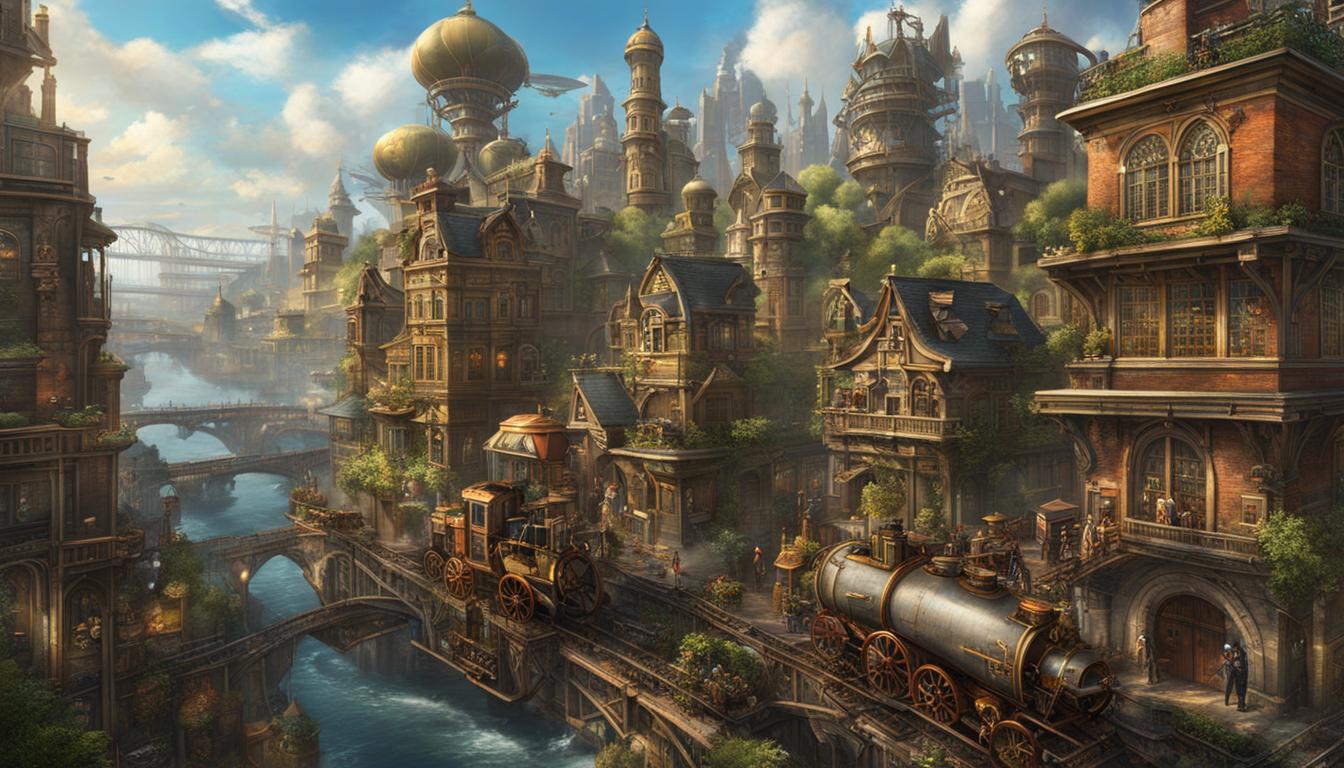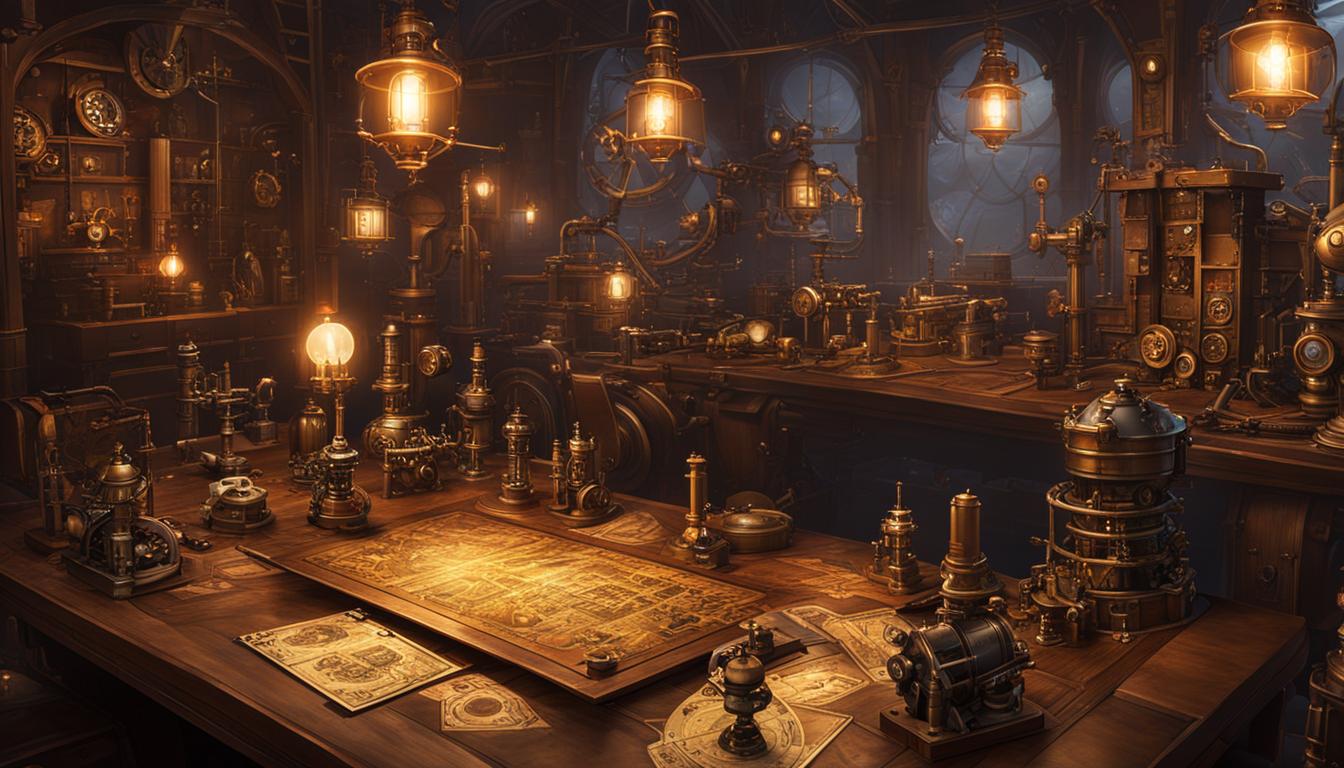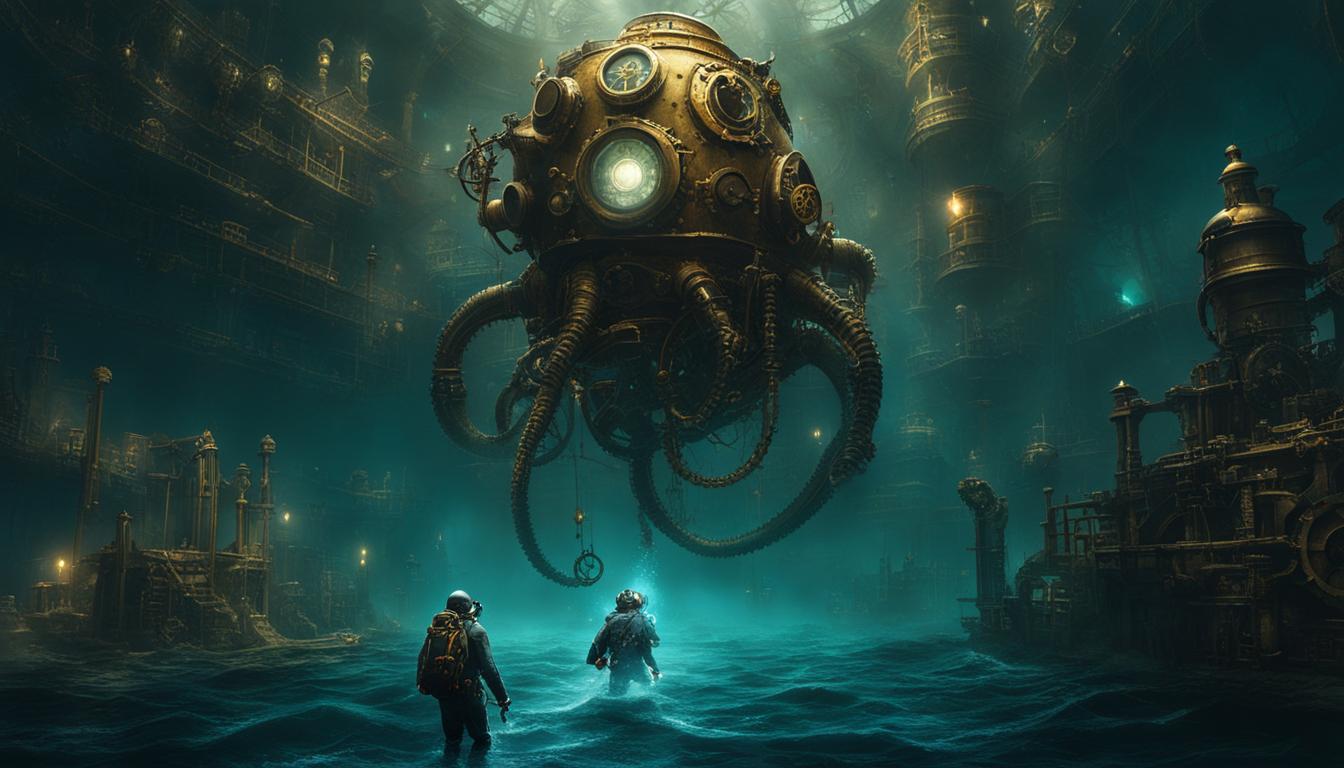Steampunk, a genre often debated as falling under science fiction or fantasy, blurs the lines with its unique blend of Victorian aesthetics and retro-futuristic technology.
While science fiction and fantasy share common elements such as dystopian futures and supernatural elements, there are distinct differences between them and steampunk. Some argue that steampunk belongs more to the fantasy genre, while others see it as a subgenre of science fiction.
Key Takeaways:
- Steampunk is often debated whether it falls under the science fiction or fantasy genre.
- It combines Victorian aesthetics with retro-futuristic technology.
- Steampunk has distinct differences from science fiction and fantasy.
- Some argue that it belongs more to the fantasy genre, while others see it as a subgenre of science fiction.
- Steampunk offers a unique blend of history, fantasy, and retro-futuristic technology.
Steampunk and Historical Fantasy: A Unique Blend
Steampunk is a genre that seamlessly blends elements of history and fantasy, creating a truly unique storytelling experience. Unlike traditional historical fantasy, which focuses on specific time periods, steampunk takes place in an alternate version of the Victorian era or the American Wild West. It incorporates retro-futuristic technology inspired by 19th-century steam-powered machinery, giving it a distinct aesthetic and atmosphere.
In steampunk, readers are transported to a world where steam-powered inventions and clockwork mechanisms coexist with the elegance and fashion of the Victorian era. It’s a genre that delights in imagining a different path for history, exploring alternative histories where different technological advancements and societal changes have taken place. This makes steampunk a genre that not only captivates readers with its fantastical elements but also invites them to ponder the “what ifs” of history.
One of the key differences between steampunk and historical fantasy lies in their approach to the past. While historical fantasy typically strives for historical accuracy, steampunk embraces creative liberties by introducing anachronistic technology and concepts. This allows for a truly imaginative blend of genres, where history is reimagined and infused with fantastical elements. Steampunk’s focus on visual and stylistic elements further adds to its allure, creating atmospheric worlds that transport readers to a bygone era.
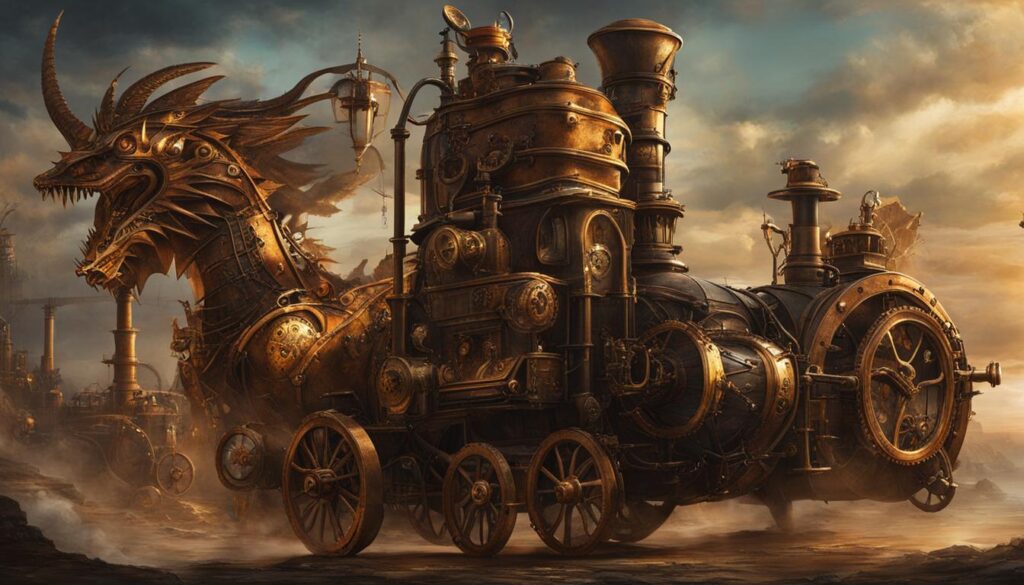
Table: Comparing Steampunk and Historical Fantasy
| Steampunk | Historical Fantasy |
|---|---|
| Takes place in an alternate version of the Victorian era or the American Wild West | Focuses on a specific historical time period |
| Incorporates retro-futuristic technology inspired by 19th-century steam-powered machinery | Usually adheres to historical accuracy |
| Explores alternative histories and societal changes | Reimagines history with fantastical elements |
| Blurs the lines between science fiction and fantasy | Typically falls under the fantasy genre |
As seen in the table above, steampunk and historical fantasy have distinct differences in their settings, approach to technology, and adherence to historical accuracy. While both genres offer captivating stories that transport readers to different eras, steampunk stands out for its unique blend of history and fantasy, creating a genre that continues to captivate readers’ imaginations.
Steampunk vs. Other Science Fiction Genres: What Sets it Apart
While steampunk shares similarities with other science fiction genres, it has distinct features that set it apart. Steampunk’s focus on retro-futuristic technology powered by steam or clockwork mechanisms gives it a unique aesthetic. It often incorporates elements of fantasy, blurring the lines between genres. This allows for crossovers with the fantasy genre, resulting in a blend of the two. Steampunk also stands out for its emphasis on visual and stylistic elements, creating atmospheric worlds that transport readers to a bygone era.
Unlike traditional science fiction, which often explores advanced technology and futuristic societies, steampunk looks to the past for inspiration. It imagines a world where Victorian-era inventions and machinery have evolved into fantastical creations. This combination of historical elements and speculative technology creates a captivating setting that appeals to readers seeking a sense of nostalgia and wonder.
Furthermore, steampunk distinguishes itself from other science fiction genres through its attention to detail and craftsmanship. The genre often celebrates intricate designs, intricate costumes, and elaborate world-building. Whether through intricate descriptions of clockwork mechanisms or lavish descriptions of Victorian fashion, steampunk invites readers to immerse themselves in a meticulously crafted world. This dedication to aesthetics sets it apart from other genres that may prioritize plot or scientific accuracy.
Steampunk and Fantasy Genre Crossovers
One of the most intriguing aspects of steampunk is its ability to seamlessly blend with the fantasy genre. Steampunk’s imaginative setting and emphasis on fantastical elements provide ample opportunities for crossovers with magic, mythical creatures, and supernatural phenomena. This fusion of two distinct genres results in a captivating mix of technology and enchantment, appealing to readers who enjoy both science fiction and fantasy.
“Steampunk has the power to transport readers to a world that combines the best of both science fiction and fantasy, offering them a unique and immersive reading experience.” – Book Critic
For example, in a steampunk fantasy novel, characters may use steam-powered airships to navigate a world filled with mythical creatures and hidden realms. The combination of mechanical marvels and magical beings creates a rich tapestry of imagination, enticing readers with its evocative and otherworldly nature.
| Steampunk | Other Science Fiction Genres |
|---|---|
| Blends history and fantasy | Tends to focus on the future and technology |
| Emphasizes visual aesthetics and atmosphere | Places more emphasis on scientific accuracy and plot |
| Often incorporates elements of the fantasy genre | Primarily explores science and technology |
In conclusion, steampunk stands out among science fiction genres for its unique blend of history, fantasy, and retro-futuristic technology. Its distinct features, including its visual aesthetic, crossover potential with the fantasy genre, and attention to detail, set it apart from other genres. Whether readers are drawn to the whimsical world of steampunk or other science fiction offerings, there is a vast range of storytelling possibilities to explore.
Conclusion
Steampunk, with its fascinating blend of history, fantasy, and retro-futuristic technology, transports readers to captivating worlds beyond their imagination. While the debate continues on whether it belongs more to the science fiction or fantasy genre, one thing is certain: steampunk has a unique allure all its own.
What sets steampunk apart are its distinct features and aesthetic. The focus on steam and clockwork-powered machinery creates a visual splendor that captivates readers. It blurs the lines between genres, often intertwining with fantasy and offering a delightful blend of the two.
Steampunk also shines bright in its exploration of alternative histories. It invites readers to imagine what the world would look like with different technological advancements and societal changes. This aspect sets it apart from other genres and opens up a realm of storytelling possibilities.
Whether readers are drawn to the whimsy of steampunk or intrigued by other fantasy worlds, one thing remains certain – the allure and distinctiveness of the steampunk genre will continue to captivate and inspire readers for years to come.
FAQ
Is steampunk considered science fiction or fantasy?
Steampunk is often debated as to whether it falls under the science fiction or fantasy genre. Some argue that it belongs more to the fantasy genre, while others see it as a subgenre of science fiction.
What sets steampunk apart from traditional historical fantasy?
Steampunk combines elements of history and fantasy to create a unique blend of genres. It takes place in an alternate version of the Victorian era or the American Wild West, incorporating retro-futuristic technology inspired by 19th-century industrial steam-powered machinery.
Does steampunk explore alternative histories?
Yes, steampunk imagines how the world would have evolved with different technological advancements and societal changes, allowing for alternative histories to be explored.
What makes steampunk different from other science fiction genres?
Steampunk’s focus on retro-futuristic technology powered by steam or clockwork mechanisms gives it a unique aesthetic. It often incorporates elements of fantasy, blurring the lines between genres. Steampunk also stands out for its emphasis on visual and stylistic elements, creating atmospheric worlds that transport readers to a bygone era.
Why is steampunk considered a unique genre?
Steampunk’s blend of history, fantasy, and retro-futuristic technology offers a unique experience for readers. Its distinct features, including its visual aesthetic and focus on alternative histories, set it apart from other genres.

